marsh, they/them, 24, queer of gender and sexuality. still largely inactive
Don't wanna be here? Send us removal request.
Photo

“I am in control and resist the desire to pull my hair”
This request hit close to home for me, which is why I made sure I was the one who took it. I, and the anon who asked for this sigil, have something called trichotillomania, which is chronic hair pulling caused by stress. To the anon, I just wanna say I know the boat you’re in; I know how hard this can be to stop, but you can, and you will. Just try to focus on how great you’ll look with a full head of hair :)
Anyways, for this write it on the back of your hands, both of them, as well as you can.
Requested by anonymous
~Richtor
374 notes
·
View notes
Text
Birdie's Sleep Crystal Spell
This is a simple spell I’ve been doing every night to give me interesting dreams and a restful sleep. It works wonders!

You will need:
⭐️ an amethyst crystal/any crystal or stone you associate with sleep and restfulness
⭐️ a window that shows the sky
Turn all the lights off in your room and hold the crystal up to the window. Look at the sky and your crystal and ask your intent either out loud or mentally, such as “give me a sweet and restful sleep” or “give me fun dreams”.
When you feel that your crystal has been charged with that intent, seal the spell by kissing the crystal and go to bed. Place the crystal under your pillow for your night to be as you asked of it!
Sweet dreams!
#hi again. im old now. i need to update my shit#not really fully actually into witchcraft anymore but i still enjoy it from time to time#anyway#lets see if i remember how to tag stuff#spell list#sleep#crystals
1K notes
·
View notes
Text



Lavender Syrup!
I know there are a ton of recipes out there, but this one's mine. I put in a lot more lavender personally.
- 2 cups sugar
- 1 1/2 cup water (here's an opportunity to use moon water for extra energy. Full moon water can boost the lavender correspondences for psychic awareness and love, while water charged in phases leading up to the new moon can boost lavender's ability to banish/protect from depression and anxiety)
- 4 tablespoons lavender- Peace/anti-anxiety, happiness, love, sleep, psychic awareness/ability, creativity, protection from ill treatment.
- purple food coloring (optional)
Instructions:
Warm the water and sugar, mixing till it dissolves, then add the lavender and mix well. When the water is boiling, lower it to simmer, cover, and let it simmer for about 10-15 minutes. If you leave it for longer, it will become bitter. Then strain into a bottle, and THEN add the food coloring if you want. This syrup is not meant to be very thick, so that it mixes easily with cold drinks just as well as warm. If you want it to be thicker, add more sugar.
7K notes
·
View notes
Text
Ancient Greek Divination Series #1: Astragaloi

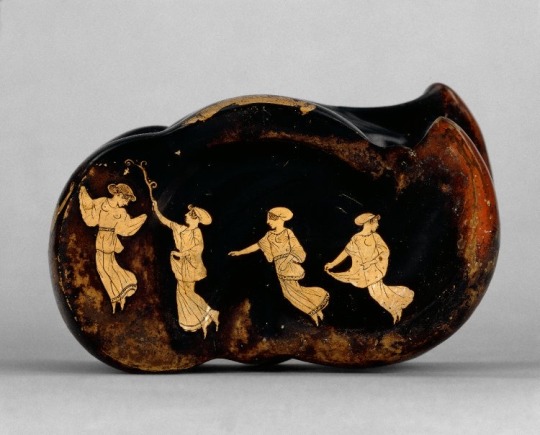
Astragaloi
What are they?
Basically, they’re Ancient dice with only four sides!
Made of sheep, cow or goat knucklebones (also called the pastern bones of the hind legs) or ceramic replicas of them
They were cast onto a table or dice tray. This tray was set on a table in front of an image of a god/goddess, usually Apollon or Hermes.
Just as dice were used for games, so were astragaloi.
🦴🦴🦴🦴
The sides of an astragalos

Khios
Narrow face; s-shaped depression
Koios/khios/coan/chios
Narrow face
Somewhat flat, irregular surface
Huptios
Means supine
Deep pit in middle
Pranes
Rounder, slightly cylindrical, broad face
🦴🦴🦴🦴

How to do an astragaloi reading
Questions asked are usually asking for advice. Both formats of the divination are more complex than yes/no.
There are at least two ways to do readings, based on two sources: Oracle Bones Divination: The Greek I Ching by Kostas Dervenis (questionable title, but useful book), and John Opsopaus’ book Oracle of Apollo and website. I personally prefer to use Dervenis’ system for astragaloi. I just read a source I’ll mention later so this is subject to change.
Standard procedure
○ Roll 5 astragaloi or one astragalos 5x
○ Read numerical value of downward (Opsopaus) or topmost (implied in Dervenis) face
○ Faces marked by shape
○ You can mark the faces with pips or alphabet too
Opsopaus style
○ Add #s of downward faces of all 5 “rolls”
○ Roll with hands, dice cup, or dice tower
○ You can blow into hand after u pick up lots to inspire divination
Dervenis style
○ Add numbers of topmost faces of all 5 rolls
○ Look up the answer by the total number obtained in his book, and by the exact number of each side (i.e. 3 khios, 1 huptios, and 1 pranes)
🦴🦴🦴🦴
Reconstructionist astragaloi
We don’t know a lot about how astragaloi were actually used, but we have the possible answers from engravings. Opsopaus references this but seems to take a lot of liberties.
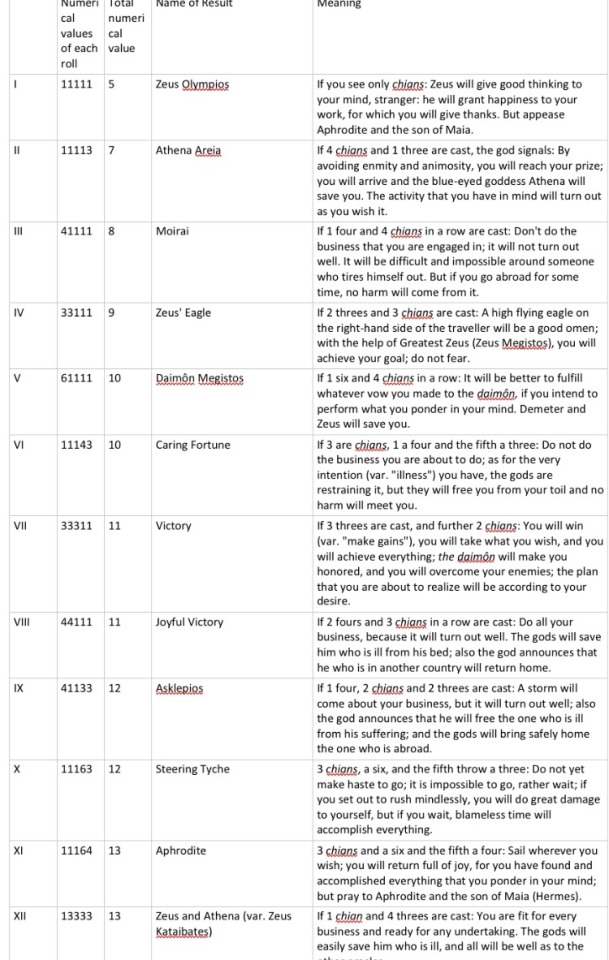
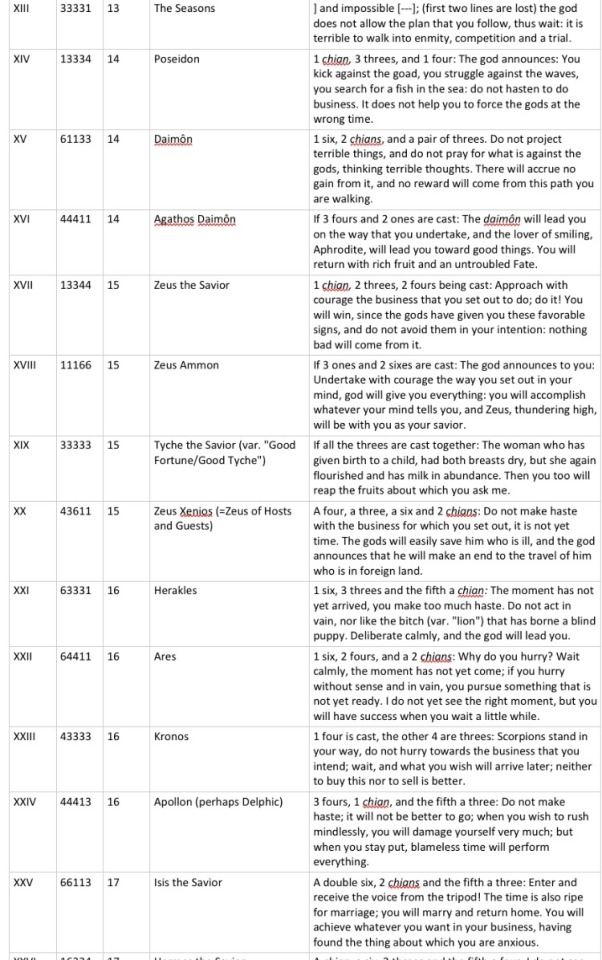
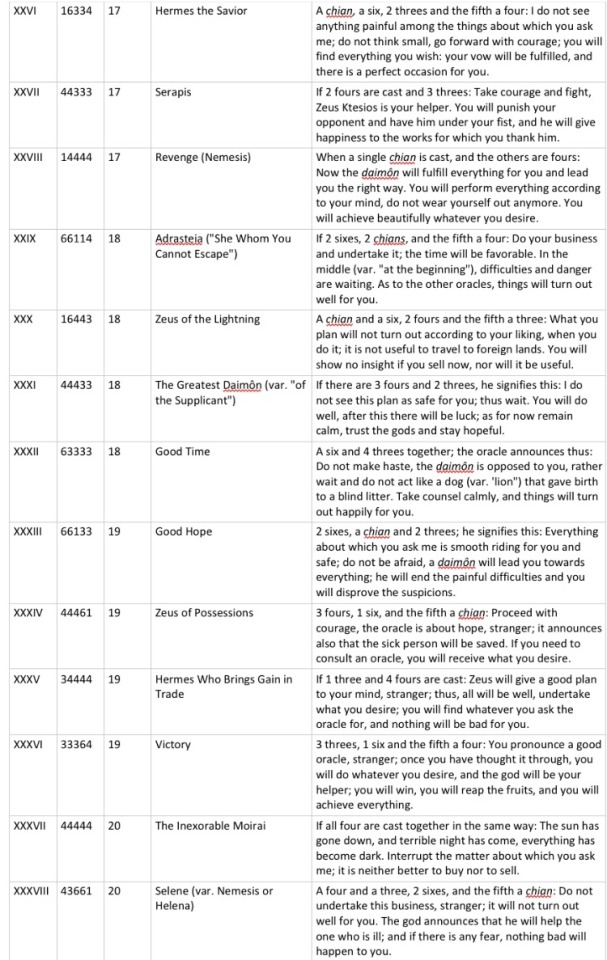
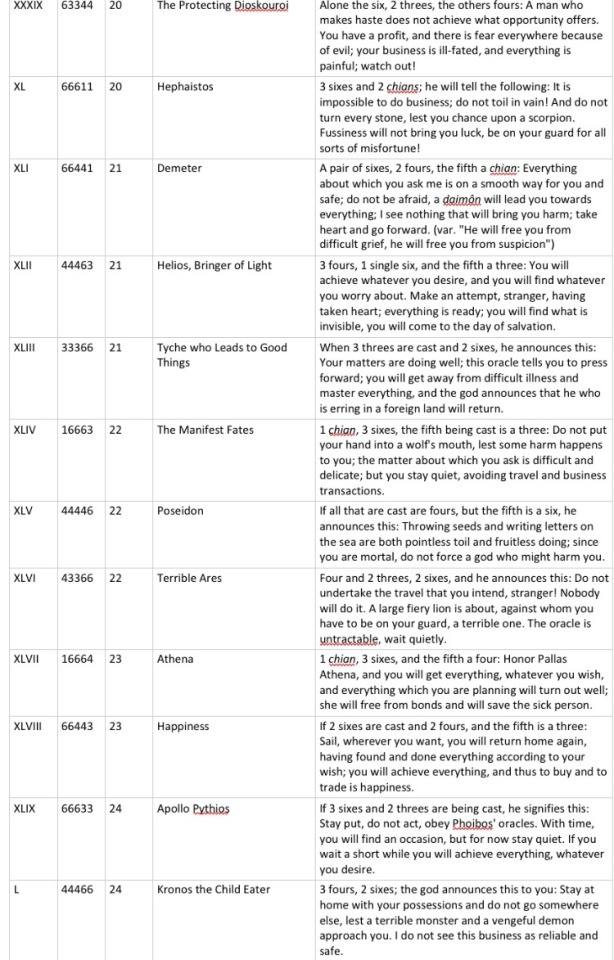
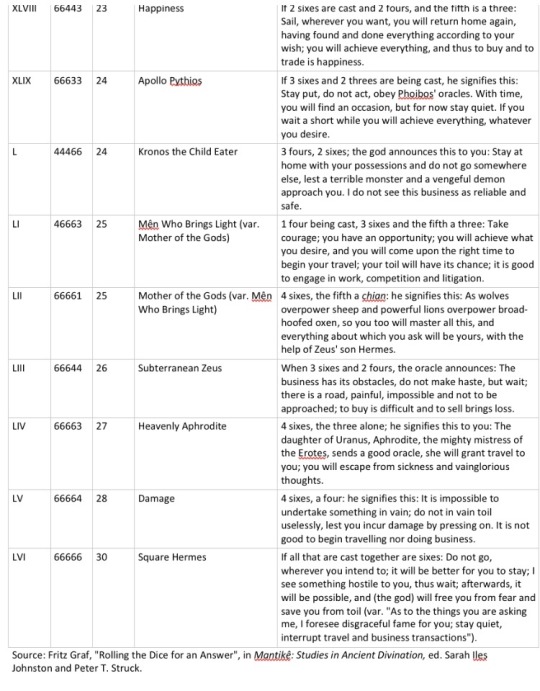
iThis is a table I made from Fritz Graf’s chapter “Rolling the Dice for an Answer” in Mantikê edited by Sarah Iles Johnston and Peter T. Struck.
🦴🦴🦴🦴
Tips for using astragaloi
If you use real bones, make sure to thank the animal for the bones! Perhaps also a deity (Artemis, maybe?).
You can also make them from wood/clay!
🦴🦴🦴🦴
Sources and further reading
Fritz Graf’s chapter “Rolling the Dice for an Answer” in Mantikê edited by Sarah Iles Johnston and Peter T. Struck
Oracle of Apollo by John Opsopaus
Opsopaus’ website
Oracle Bones Divination: The Greek I Ching by Kostas Dervenis
Background image
Other images: dice and astragaloi, painted astragalos. Knucklebone sides from Dervenis’ book, and girl playing with astragaloi from Wikimedia Commons
932 notes
·
View notes
Text
heads up: probably going to be shelving this blog permanently. i just don’t connect to this lifestyle anymore. im leaving the blog itself up because i still stand by my posts (for the most part. im sure there’s some old nonsense in here somewhere) and i want people to be able to find it if they want to.
4 notes
·
View notes
Photo

Skeleton of the now extinct auroch
11K notes
·
View notes
Text
if being asked to examine your own anti semitic behavior is going to give you an ‘identity crisis’ if its not worded politely enough then you should uh, probably go ahead and have one
643 notes
·
View notes
Photo

Prehnite Berceto, Parma Province, Emilia-Romagna, Italy
312 notes
·
View notes
Photo

#remember it always goes like this#only villains spell it like magick#villains and people who have been influenced by them without realizing it
10K notes
·
View notes
Text
The Law of Attraction, Prosperity Gospel, and Other Ways of Controlling How People Think

In the words of Rhonda Byrne, who brought the Law of Attraction to popular consciousness with her book The Secret: “Life doesn’t just happen to you; you receive everything in your life based on what you’ve given.”
Or, to put it even more bluntly: “You attract to you what you think about most.”
At first glance, these words seem empowering. We all want to be the masters of our own destinies. It’s that desire for autonomy and agency that attracts many people to witchcraft and alternative spirituality in the first place.
Until very recently, I was a firm believer in the power of the Law of Attraction. I believed that it worked the same way magic did, and I encouraged other witches to add it to their spiritual toolbox. I even included an episode about it in my Baby Witch Bootcamp series. (Which you will notice has since been taken down.)
That all changed when I started reading a book about mind control.
For context: I grew up in the Church of Jesus Christ of Latter Day Saints, better known as the Mormons. Whether the Church is a cult or not is up for debate, but it definitely uses cult thought control techniques to control its members. Although I left the Church several years ago, I never untangled myself from the Church’s flawed and harmful rhetoric. Recently, I’ve decided to take on this challenge, and I started my healing process by reading the book Recovering Agency: Lifting the Veil of Mormon Mind Control by Luna Lindsey. This is an extremely well-researched book about how the Mormons use cult thought control techniques to keep members enmeshed.
In a section on the Church’s mandatory tithing (a sort of tax paid to the Church by members) and promise that tithe-payers will be rewarded with material wealth, Lindsey quotes the book Recovery from Cults by Paul R. Martin. Martin says: “The prosperity gospel holds the conviction that if a believing person has enough faith, is completely repentant of all sin, and gives at least 10% of his or her income to the church or to some Christian ministry, then he or she will have good health, obtain financial wealth, and experience general prosperity in all areas of life.”
I was taken aback by how similar this concept — the so-called prosperity gospel — is to the Law of Attraction. Prosperity gospel teaches that faith in God will be rewarded with material blessings. The Law of Attraction teaches the same thing, but replaces the word “God” with “the Universe.” In both cases, believers are encouraged to focus only on the positive while ignoring or minimizing any problems they may face.
In the church I grew up in, we were taught that doubt comes from the devil and prevents us from receiving God’s blessings. Dieter F. Uchtdorf, a member of the governing body of the Mormon Church, says: “We must never allow doubt to hold us prisoner and keep us from the divine love, peace, and gifts that come through faith in the Lord Jesus Christ,” and coined the popular Mormon mantra “Doubt your doubts before you doubt your faith.”
In The Secret, Rhonda Byrne quotes Henry Ford: “Whenever you think you can or think you can’t, either way you are right.” Later in the book, Byrne says, “Instead of focusing on the world’s problems, give your attention and energy to trust, love, abundance, education and peace.”
I was struck by an eerie similarity between Uchtdorf’s and Byrne’s words. I had turned to the Law of Attraction as a means to empower myself after trauma connected to conservative Christianity and its values. Was it really possible that I had merely swapped one kind of thought control for another?
This lead me to look into other similarities between the Law of Attraction and other forms of thought control, and what I found was frankly disturbing.
The Law of Attraction employs at least three of the four components of the BITE model, an illustration of cult mind control techniques created by cult expert Steven Hassan. The four aspects of the BITE model are: Behavior Control, Information Control, Thought Control, and Emotional Control. These are techniques used by cults to mold the identities of their members.
Both prosperity gospel and the Law of Attraction employ Behavior Control; prosperity gospel demands outward displays of faithfulness from believers, while the LoA teaches that we should “make sure that [our] actions are mirroring what you expect to receive,” as Byrne puts it (i.e., act like our lives are already perfect). Both systems employ Thought Control; prosperity gospel warns believers to keep their thoughts pure (“If ye do not watch yourselves, and your thoughts, ye must perish.” – Mosiah 4:30), while the LoA teaches that all of our thoughts have energetic vibrations and that we should focus on “high vibrational” thoughts. Both systems employ Emotional Control; prosperity gospel labels certain emotions as sinful and promotes shame around these “sins”, while Rhonda Byrne tells us to, “Ask once, believe you have received, and all you have to do to receive is feel good.”
The fourth aspect of the BITE model is Information Control. Although not everyone who believes in either prosperity gospel or the Law of Attraction will engage in Information Control, many do. Many Christians are encouraged to avoid media or informational resources that contradict the Church’s message — I know I was in my church. Believers in the Law of Attraction are encouraged to avoid “low vibrational” media and anything else that makes them feel even a little uncomfortable. In either case, this selective consumption of information feeds into confirmation bias and creates a closed system of logic. As Luna Lindsey puts it in Recovering Agency, “All signs point to ‘Yes.’ It transfers the burden of proof to an emotional basis for evidence, which is extremely easy to engineer.”
But Sam, you may argue, the Law of Attraction is a belief — it isn’t tied to any organization! There is no Law of Attraction cult!
Tell that to authors like Rhonda Byrne and Esther Hicks, who are making millions of dollars from books about the Law of Attraction. Tell it to the thousands of people who treat those books like gospels, and those authors like modern day prophets. Tell it to the life coaches and “lifestyle gurus” building social media empires by appealing to people who want to believe that they can manifest their dream life just by changing their thoughts.
And that rhetoric is inherently flawed. Both the Law of Attraction and prosperity gospel employ cognitive distortions in order to plug holes in their logic. Cognitive distortions are irrational or illogical thought patterns, and overcoming cognitive distortions is one of the main goals of Cognitive Behavioral Therapy (CBT).
Both prosperity gospel and the Law of Attraction often lead to overgeneralization (the tendency to find patterns where none actually exist), personalization (believing that everything other people do or say is a personal reaction to us — taking everything personally), blaming ourselves for situations and events outside of our control, and the fallacy of change (expecting other people or situations to change to meet our expectations). All of these are cognitive distortions.
The biggest and most obvious of these cognitive distortions is black and white thinking, also called all or nothing thinking. As Luna Lindsey points out in Recovering Agency, black and white thinking is also a common element in cult thought control. Black and white thinking divides everything into “either/or” categories, with no room for shades of gray. In terms of mental illness, someone with an anxiety disorder may feel that if they can’t be perfect they’re a total failure — this is an example of black and white thinking. In conservative Christian theology, everything is either righteous or sinful, aligned with either Jesus or Satan — this often leads church members to feel like the world is out to lead them into sin. In the Law of Attraction, everything is either “high vibrational” or “low vibrational” — you never hear about neutral emotions or experiences.
In fact, the concept of low vs. high vibrations is just a way of rebranding the Christian concept of sin vs. righteousness. Take virtually any quote from a Law of Attraction author, replace “low vibration” with “Satan” and “high vibration” with “Jesus” and you’re left with typical conservative Christian rhetoric.
(By the way, the idea of emotions having vibrations seems to have originated with the book Power vs. Force by David R. Hawkins. I can find no scientific evidence to support the idea that different emotions have noticeably different frequencies. The idea of sin is just as unverifiable, since there’s no way to prove that something is or is not sinful.)
Finally, both prosperity gospel and the Law of Attraction can have a negative affect on the mental health of people who believe in them. A study from the University of Toronto, lead by Nick Hobson, Geoff MacDonald, and Juensung Kim, found that exposure to prosperity gospel sermons lead to an increase in risky financial behavior.
“New research out of the University of Toronto’s department of psychology in the Faculty of Arts & Science suggests that exposure to prosperity gospel messaging – thinking God wants you to be wealthy, prosperous and donate money to the church – makes you more likely to show an exaggerated and unrealistic sense of optimism for life and take more financial risks,” Alexa Zulak says in an article for U of T News. “Hobson says atheists and agnostics were just as likely to be susceptible to ‘unrealistic optimism’ – as long as the prosperity sermon they watched was masked as a motivational speech. Even when the research team removed all references to God and religion, participants still exhibited increased optimism – meaning the messaging is less about God and religion.” [Emphasis added.]
These ideas are dangerous, whether they’re packaged as gospel or a manifestation technique. And that’s not even getting into how both of these systems can contribute to perfectionism, victim-blaming, or toxic positivity.
I’m not the only witch who has noticed a disturbing similarity here. @north-of-annwn has a great post on this subject, where they say that, “The Law of Attraction is just Prosperity Gospel and Thought Control repackaged in a new age wrapper.”
They go on to explain how both of these systems are inherently ableist and are based in privilege. Later in that post, they sum up exactly why the Law of Attraction is so dangerous: “It introduces a fear/shame relationship with your own thoughts.”
So… yeah. I’m going to go ahead and admit that I was wrong — wrong about the Law of Attraction and wrong to spread these ideas to other witches without doing more research first. I hope that this post has been informative, and that this information will serve readers on their journey to find a spiritual belief system that serves and empowers them — without telling them how to think.
#its worth analyzing the link between the loa and regular manifestation rhetoric#just food for thought
2K notes
·
View notes
Text
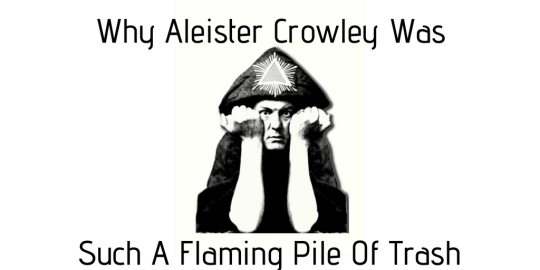
For starters, if you don’t know who Crowley was (no, not the Supernatural dude), he was a 1900s occultist who coined a portion of what modern witchcraft uses today, such as the word “magick” which he, although did not ‘invent’, popularised. (you’ll learn why I denounce that term and try to educate people who use it in a second). He was, in a nutshell, everything modern society hates. Racist, antisemitic, sexist, you name it and Crowley was it.
Crowley wrote several books about the occult, some of them having slightly useful information and still are referenced today, but his occult books are not what I intend to talk about. Little known to most, Crowley wrote an essay entitled “The Jewish Problem”, that title is enough of a disgrace, but what is actually IN the writing is atrocious, which I will be going over in a second. In other writing, he refers to Jewish people as “parasites”, “a barbarous race”, talks about how Jewish people are their bad stereotypes, among other things. This article does a wonderful job of compiling some of his worst quotes and explaining how racist he really is, as well as explaining some of the undertones of the quotes.
“Christians and other troglodytes — but most especially the parasites of man, the Jews (The New Comment on Liber AL, III:11)“
“the Jews were an entirely barbarous race, incapable of any spiritual pursuit. (preface to 777, printed in The Equinox, Vol. 1, No. 8)”
“A similar case is presented by the Jew, who really does only too often possess the bad qualities for which he is disliked (Confessions, chapter 54)“
“But in America, the Christian elements have been removed so that wealthy Jews may reach the summit of masonry. (Confessions, chapter 72)“
“It has been said that every nation has the government which it deserves. I would add, the type of Jew which it deserves. (Confessions, chapter 61)“
“the Jews are a critically important factor in the social and economic problems of the day (Confessions, chapter 75)“
Anyway, he also used to throw slurs at his Jewish friend Victor Neuburg and admitted to being interested in fascism multiple times.
As for quotes from The Jewish Problem:
“Israel has corrupted the world, whether by conquest, by conversion, or by conspiracy. The Jew has eaten his way into everything.”
“The Jew, living so long on sufferance, by subterfuge, servility, and self-effacement, has taught his tricks to the whole world.“
And many, many, many more.
Some of his comments on other groups of people:
About Chinese people: “One cannot fraternize with the Chinese of the lower classes; one must treat them with absolute contempt and callousness“ / “The Chinese does not respect the white man as the Indian does — for his possession of high moral qualities.“
About Mexican people: “Neither the coyotes nor the turkey-buzzards will touch a dead Mexican. His flesh has been too thoroughly impregnated with chillies and other pungent condiments.”
About black people: “Where Islam and Christianity meet in open competition, as in some parts of Africa, it is found that only the lowest type of Negro, such as is accustomed to arrange matters with conscience by hanging a rag on a piece of stick, accepts Christianity”
About Indian people: “I am not fond of Benaglis at the best and he as the worst specimen of his race I have ever seen. He was fat and oily, with small piglike treacherous eyes.”
Crowley also heavily used the term “black magic” in reference to the “dark art” types of witchcraft, this term is now considered racist by a good portion of the community. Not to mention he was also a regular user of the N slur! I’m talking hard-R.
He was also heavily misogynistic and sexist, as if the dude wasn’t enough of a crapshoot. Here is a list of all the gross, sexist things he’s said!
Anyway,
I never much liked the usage of magic with a K to start with, but I’ve been learning more and more about AC as time has passed, I’ve started denouncing it entirely and educating people about it’s connections to him as best as I can, most people have no idea how awful he is. It’s scary to think that someone so despicable is still heavily referenced and worshiped in the Occult community, so I wanted to finally make this post. I am asked a lot about it and why I hate the term “magick” so much, now you all know. I hope you will consider using the terms witchcraft, or even just magic rather than adding the K at the end, because we all know what the K stands for now, and who it represents. This is not even the beginning of how awful he was, there is so much more that can be dug up. I encourage you to do it, research him and understand how absolutely terrible he was. Please.
In conclusion:

Thank you for coming to my TED Talk.
Special thanks to @alistaires
#crowley was a huge piece of shit#gardner was too but not as much as crowley and besides thats an essay for another day#antisemetism#racism
12K notes
·
View notes
Text

Death

The Nine of Cups
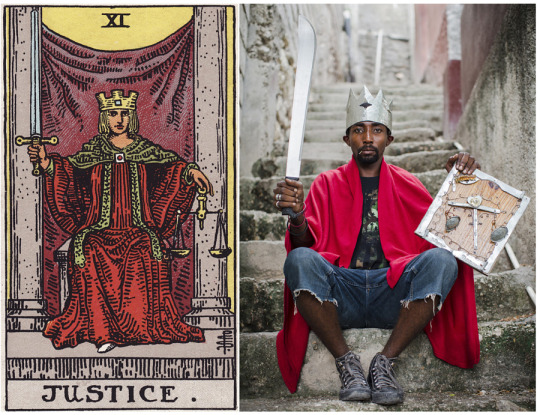
Justice

The Nine of Swords
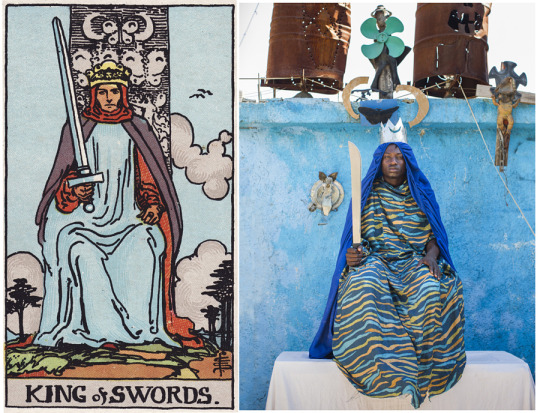
The King of Swords
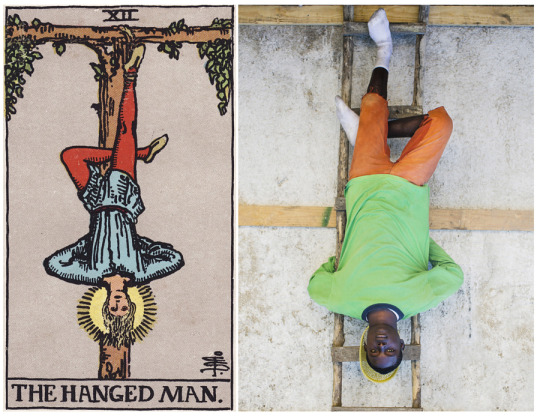
The Hanged Man

The Hermit

The Six of Swords
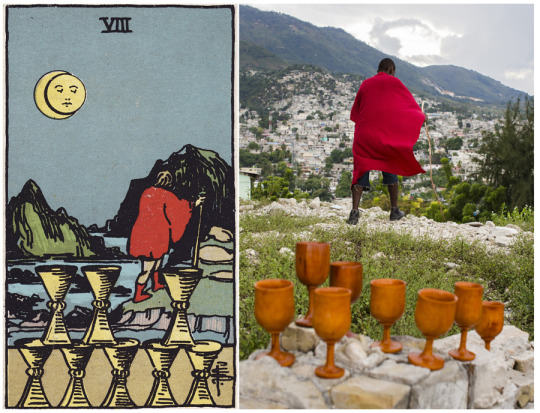
The Eight of Cups

The Five of Cups
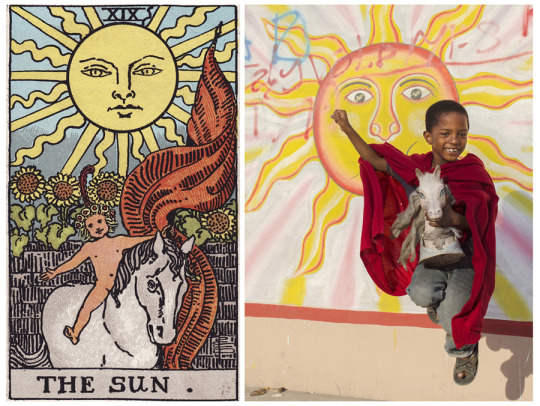
The Sun
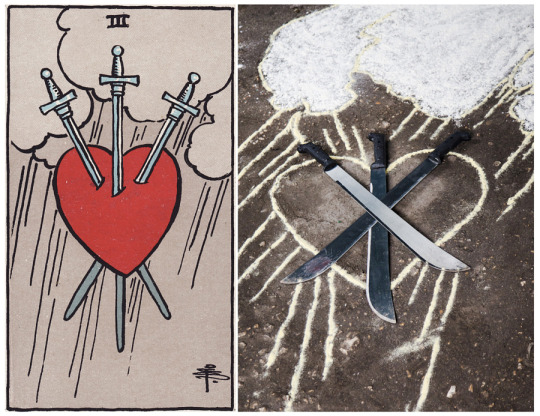
The Three of Swords
‘The Ghetto Tarot’: Haitian artists transform classic tarot deck into stunning real life scenes:
Welcome to the Ghetto Tarot, a project from award-winning documentary photographer Alice Smeets and a group of Haitian artists known as Atis Rezistans. The idea was to take the classic Rider-Waite tarot deck of 78 cards and create a photographic version of each card using settings and objects in the vibrant ghetto of Haiti.
As Smeets says, “The spirit of the Ghetto Tarot project is the inspiration to turn negative into positive while playing. The group of artists ‘Atiz Rezistans’ use trash to create art with their own visions that are a reflection of the beauty they see hidden within the waste. They are claiming the word ‘Ghetto,’ thus freeing themselves of its depreciating undertone and turning it into something beautiful.”
57K notes
·
View notes
Text

Death

The Nine of Cups

Justice

The Nine of Swords

The King of Swords

The Hanged Man

The Hermit

The Six of Swords

The Eight of Cups

The Five of Cups

The Sun

The Three of Swords
‘The Ghetto Tarot’: Haitian artists transform classic tarot deck into stunning real life scenes:
Welcome to the Ghetto Tarot, a project from award-winning documentary photographer Alice Smeets and a group of Haitian artists known as Atis Rezistans. The idea was to take the classic Rider-Waite tarot deck of 78 cards and create a photographic version of each card using settings and objects in the vibrant ghetto of Haiti.
As Smeets says, “The spirit of the Ghetto Tarot project is the inspiration to turn negative into positive while playing. The group of artists ‘Atiz Rezistans’ use trash to create art with their own visions that are a reflection of the beauty they see hidden within the waste. They are claiming the word ‘Ghetto,’ thus freeing themselves of its depreciating undertone and turning it into something beautiful.”
57K notes
·
View notes
Text
A quick note to all the witches in the first years of their practice -
No one gets to call you a beginner or a baby witch unless you yourself are comfortable with it.
No one gets to use your inexperience or lack of knowledge on a given topic as an insult or as an indication that you are somehow lacking in skill or intelligence.
No one gets to tell you when you’re ready or allowed (ffs) to attempt a given type of spellwork.
No one gets to tell you that you’re “not a real witch” until you’ve done a certain number of spells, or studied a certain array of subjects, or been practicing for a certain length of time, or until you reach whatever nebulous goal they’ve set.
If you want to say you’re a baby witch or a beginner witch, that’s fine. But you decide when that designation ends. You decide when you’re no longer a beginner. You decide when you’re ready to try something. And you decide what you do and do not study, so long as no boundaries of cultural appropriation are being crossed.
The second you set your foot to the path, you’re a real witch. And unless you’re in an initiatory tradition under direct and dedicated mentorship, the only person who can speak on your progress or your readiness is YOU.
We were all beginners once. We were all inexperienced once. We all started somewhere. And some witches seem to forget that.
Please don’t let unnecessary gatekeeping keep you from enjoying the study and practice of your craft.
1K notes
·
View notes
Text


Some fantastic birds of prey from my personal collection.
113 notes
·
View notes
Photo

Getting back into the swing of things by fixing up my articulated deer leg! I pulled out my new rotary tool to practice drilling and after figuring out the correct placements it was a very easy process. A fallen oak tree made a perfect base for this piece.
228 notes
·
View notes